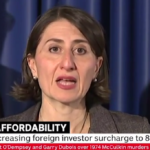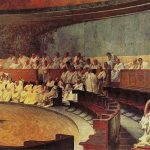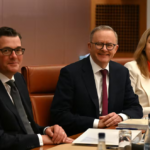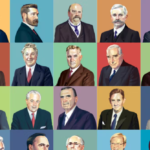Press freedom and the protection of children
Campbell Reid, Group Editorial Director at News Limited, gave the keynnote address at this year’s Australian Press Freedom Media Dinner. He was introduced by Walkley Advisory Board Chairman, Laurie Oakes. Thanks to the Walkley Foundation for sharing this transcript.
Thank you Laurie.
Chris has already covered some of the international issues.
I want to focus on the more pressing domestic issues and the opportunity we now have to fix them.
The Northern Territory Care and Protection of Children Act is clear enough:
If you think children are being sexually abused it is an offence if you fail to report it to the police immediately. But apparently, it’s not OK for the media to report the abuse to the public.
In March this year Northern Territory Police denied there was an issue of child prostitution in Alice Springs. But, in fact, they knew there was. The Centralian Advocate newspaper published a story about the abuse. What happened next is instructive.
Chris Merritt reported in The Australian that the day after the Advocate story its editor and reporter were invited to the local cop shop for what was described as a casual discussion.
No legal action was taken but the police attitude was clear. If the paper had evidence of child prostitution it was the paper’s duty to inform the police, NOT inform the public. This is the same police force – who perhaps learning from their colleagues in Victoria and Queensland – has taken it upon itself recently to track reporters’ telephone calls.
In preparing for this speech I haven’t had to trawl back over many years to find examples of how press freedoms are at risk in Australia. I’ve only had to look at my email inbox. There isn’t a day that I don’t see a court notice to take down a story from one of our websites or flag it with a legal alert in archives.
Some days, I literally watch a blizzard of these ‘take down’ notices scroll across my screen. But according to the president of the NSW Law Society, this welter of suppression orders only relate to a minority of cases.
I guess it depends on what you think the word minority means. Last year we faced over 500 cases that were subject to suppression orders, 270 of those in Victoria alone.
Our best guess is that at any one time there are about 1000 suppression orders that prevent some form of reporting or other. But no one really knows. Some courts won’t reveal how many there are. In NSW no official register is kept by any court.
Just before Easter in South Australia a Labor Minister was arrested and charged with possessing child pornography. The Minister resigned.
He couldn’t be named in South Australia and the two stories could not be run so that anyone would suspect the two events were connected. The Advertiser could not publish what it knew was true. [Note to editors: this paragraph cannot be broadcast or published in South Australia].
In May last year, The Weekend Australian pulped 70,000 copies of its magazine because a judge believed a jury hearing a murder trial in Melbourne would be influenced by an article about an unrelated murder in South Australia.
In February, my boss John Hartigan gave a speech on courts and the media in the digital age. In it, he argued that the integrity and independence of courts can only be upheld when they are open to full scrutiny. The public, ‘Harto’ said, had a right to understand – and witness for themselves – the laws that govern them.
Not so says the NSW Law Society. Responding a week later its president argued that:
Allowing TV crews and digital media into courtrooms wouldn’t necessarily help the public understand the legal system – BUT might actually make things worse.
He also said, and I quote:
“Judges and lawyers are highly trained specialists in legal proceedings. The nuances of criminal and civil proceedings may generate confusion in the general public if unexplained”.
An obvious response would be to suggest that if judges and lawyers can understand complex legal issues perhaps they can also learn how to communicate in plain English.
The Law Society President went on to say that suppression orders and take down orders are used to protect society and people’s rights.
Clearly he had Tony Mokbel in mind.
I have a different view. The suppression orders in the case of the now convicted gangster Tony Mokbel should be the high point in suppression lunacy.
As Justin Quill, lawyer for The Herald and Weekly Times wrote on April 20 after Mokbel was convicted, “Well, the secret is finally out. Tony Mokbel is a crook. But you knew that right?”.
When Mokbel pleaded guilty 23 suppression orders that had shrouded his trial in secrecy were lifted. In total more than 40 orders had been made in relation to the trial. Mokbel’s name had not appeared in print in Victoria for 2 years.
Episodes of Underbelly were recut so that potential jurors in Victoria didn’t see a fictional account of what they already knew to be fact.
At the core of this fixation with suppression orders in Australian courts is a fundamental belief that people selected for juries are unable to distinguish between evidence presented in court and information available from other sources.
But, as Justin Quill points out – at the time when Mokbel’s notoriety was at its peak – just after his capture in Greece – he was acquitted of a murder – proof surely that the jury acted on the evidence before it and not what it may have gleaned from the media.
If the Law Society President wants the public to understand the nuances of the law or the complexities of a case, then court proceedings should be truly open.
- Transcripts should be available on the same day.
- There should be a live or near live feed of proceedings on the internet. It worked in the C7 case and didn’t seem to corrupt the process or the judgment.
- Reporters should have same day access to court files, exhibits and affidavits, especially when they are referred to in open court during cross examination.
Some judges allow this, but the majority don’t. Some registrars require written requests from reporters. And then say no.
In other instances, court documents will only be provided in person. No faxing, no emailing, no Australia Post.
Illustrators with a box of paints no longer belong in courtrooms. TV and still cameras do – but obviously with some rules so that vulnerable witnesses are properly protected.
I much prefer the attitude of Victorian Chief Justice Marilyn Warren. In April last year she said:
“The capacity of journalists to reduce to a very confined form the salient points of a case and the reasons for a judge’s decision is often astounding…The quality is consistently high and often superb.”
Now that’s what I call a verdict.
Tonight, I call on our governments to take concrete steps to complete vital reforms.
The new Freedom of Information laws introduced federally and in some states are making a difference.
The new Information Commissioner is attacking his role with great conviction, sending a message to bureaucrats who are trying to white-ant the system that culture change is coming.
The new Federal shield laws are also a major milestone and the Federal Attorney General is to be commended on that, as is the shadow minister, Senator Xenophon and Andrew Wilkie.
But elsewhere things have stalled. The long promised legislation to protect whistleblowers has slipped off the radar. Alan Kessing remains a criminal, his appeals mired somewhere in a fug of inertia.
The 3 year old review by the Law Reform Commission into secrecy provisions is gathering dust in a drawer.
The first concrete step that’s needed is for governments to replace suppression with transparency in our court system.
I’ve already spoken about this at length. But think about this. In 2008 the Federal Attorney General proposed a new national register of suppression orders.
The concept was approved last year – 2 years later – and a working group has now been established but nothing has emerged yet – 3 years later.
The real issue isn’t that it’s taken 3 years to set up a register and we still don’t have one. The issue is we need far fewer suppression orders.
So it’s time to step up the pressure. Again.
We are in the first year of a new Federal parliament and we have new governments in the two biggest states with handsome majorities and strong mandates. We need to strike while the iron is hot because as recent history shows it doesn’t stay hot for long.
I recently came across a memo from one of the great minds of modern democracy speaking about the desire for transparency among the members of incoming governments. To a political staffer he wrote this:
I understand your anxiety about the new government’s fixation on ”transparency’’, but you are distressing yourself unnecessarily. It afflicts all incoming administrations. It used to be called ”open government’’, and reflects the frustrations they felt when they were in opposition and could not find out what was going on, combined with an eagerness to discover and publicise the deception, distortions and disasters of their predecessors.
But it does not last beyond the first few months. As time passes they realise they have more to lose than to gain from public knowledge of what they are up to. Each month increases their tally of catastrophic misjudgements, pathetic deceptions, humiliating retreats and squalid compromises. They very soon come to understand that sound and effective government is only possible if people do not know what you are doing. The Freedom of Information Act was the greatest blow to firm and decisive administration since the execution of King Charles I. Quite soon our new masters will realise that secrecy may be the enemy of democracy, but it is the foundation of government.
The author, you might recognise is Sir Humphrey Appleby, from the spectacularly accurate television series Yes Minister.
With his words in mind, I call on those of us in this room that still buy printers’ ink by the tonne and still own broadcast licences to step up the pressure on the recently elected and soon to be elected State governments of Australia to have the courage to bring about the changes they know are necessary.
The second concrete change we need is to lift the veil that keeps the harm and abuse of children a dirty secret in this country.
Whenever it becomes known that a child has been murdered Sydney newsrooms have to take down stories if they might prejudice the upcoming trial. This is helping to deliver justice to children how precisely?
You may recall the so-called Cowra murders a few years ago.
Under NSW law the murdered child couldn’t be named without the permission of one of their parents. That permission was granted by the father. The mother was a victim but had survived and was in hospital. The child’s murderer was the mother’s father.
The next day the wounded mother withdrew permission for her child to be named. That meant we couldn’t name the child, her mother or father, or the then alleged murderer, the little girl’s grandfather, even though by then he had been apprehended and charged.
Ironically, the murderer was caught in the few hours in which his identity could be publicised because a man in Cowra saw his picture on TV and called the police to tell them where he was.
When a child who is known to DOCS is harmed or dies:
- You can’t name the child, the parents, the siblings, use any photographs or disclose the address where they lived.
- You can’t in fact do anything that will in anyway identify that child, living or dead.
And the only way you can find out in where or in what conditions foster children are living in is if someone from DOCS risks their career to tell you.
The protocol of secrecy designed to protect children has demonstrably failed and must change.
The third thing we need to look at urgently is how shield laws, suppression orders and protection for whistleblowers will work in practice in a world of converged media.
The Federal Government is in the process of establishing a three person committee to study media convergence and it is to be congratulated for doing so.
In the converged media space: digital platforms, television broadcasters, newspapers, radio networks, and the ubiquitous two Harvard drop outs in a garage, compete for the same eyeballs.
But they aren’t governed by the same rules.
Why should traditional media or big media be held to a different standard than new media?
As we have already seen, what can be made public in one state can’t be made public in another.
What can be printed in newspapers can’t always be published online. A report on TV and a report published by a newspaper masthead are going to be virtually identical on a device like an iPad.
If those reports trigger complaints the broadcaster would be dealt with by the Australian Broadcasting and Media Authority. It has statutory power to impose penalties.
The newspaper report would come before The Australian Press Council, an independent body comprising industry and public members.
Either way, only mainstream media will be held to higher standards of accountability, accuracy, balance, fairness and so on.
The independent online site or the blogger doesn’t face any sanction at all unless a complainant believes the respondent could actually afford to fund an adverse finding of defamation against them.
The new federal shield laws will cover mainstream media and bloggers.
VIC and NSW are to be congratulated for proposing improved shield laws for professional journalists. But both state attorneys have said only mainstream media will be covered by their new shield laws. They cite good reasons for this.
But, what consequences might arise if mainstream media is restricted in ways that don’t apply to new media or the blogosphere?
While we might have taken down stories about Kiesha Abrahams the internet is full of content about her – some are heartfelt tributes, some call for the death penalty for her parents.
Professionally researched reporting is being censored off websites because it might prejudice a jury but bloggers are free to post hate pages online.
I am not proposing we find new ways to torture ourselves into compliance as we expand onto new platforms.
I am calling on courts and government to understand that the information dam has burst and no amount of rearguard regulation is going to stop the torrent already engulfing public life.
The warning is this: If legislators and the judiciary only restrict professional media then amateur media will fill the vacuum. Inadvertently our status as professionals – held to different and more demanding standards – will become another pressure that threatens our viability.
I commend the early work of recently appointed Press Council chairman Julian Disney in thinking about how the standards of journalism are both upheld and held to account as media converges in the digital arena.
I call on our industry, the journalism industry, not the television, newspaper or radio industry to get across this vital issue and contribute to the work of the Government’s convergence committee.
Press freedom is a matter of public interest and the public should be interested in it.
Ask any Australian if they live in a free society and they would answer yes. We know in our hearts they are not wrong.
I liked Ross Gittins’ recent article in the Sydney Morning Herald when he talked about the context in which questions are framed.
So, is Australia free?
Frame the question against Fiji, Zimbabwe, Libya or China, and, the answer is yes of course.
But if the question is whether Australia is as free as it could or should be, the answer is NO.
Under current law or accepted practice anyone employed by government – a nurse, a bus driver, a police officer etc – faces disciplinary action if they speak to the media.
Reporters can call a school to ask the principal about bullying or the government building revolution. The principal might be watching a video of the bullying incident on YouTube when the reporter rings. But they won’t be able to comment without risking censure, perhaps their career.
We can call social workers in indigenous communities to ask about petrol sniffing or alcohol abuse or the effectiveness of the intervention. But they can’t talk to us.
In his Press Freedom speech to this gathering in 2009 Laurie Oakes praised the work of John Faulkner to transform Freedom of Information laws to “shift from a culture of secrecy to one of openness and transparency.”
Oakes then warned, “all the fine sentiments expressed seem to stop at FOI.”
Well, most recently there has been progress on shield laws. But in general I’d say since Faulkner retired the shift from secrecy to transparency has less momentum now that it did then.
There is no limit to the height of the rising tide of information or the sources from which it will spring. We simply can’t afford to let legislators boil the ocean for another two or three years to then tell us that there is sand at the bottom.
As Sir Humphrey would have said:
“The Official Secrets Act is not to protect secrets. It’s to protect officials.”
Thank you.
This speech is republished with the kind permission of Campbell Reid and the Walkey Foundation.
Campbell Reid joined News Limited in 1981 where he worked as a journalist at The Daily Telegraph. He was appointed chief-of-staff in February 1988 just before he moved to New York to front the News Limited New York Bureau. When he returned to Australia in 1991 he took up the role of assistant editorship of The Daily Telegraph. In 1997 Mr Reid was appointed editor of The Australian before he then became the editor for The Daily Telegraph in 2001. In 2005 Campbell moved to Brisbane to take up his position as general manager at Queensland Newspapers. This lasted for two years before Campbell returned to Sydney as News Limited’s Group Editorial Director.













